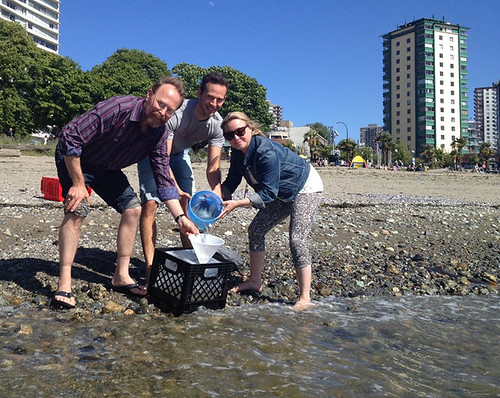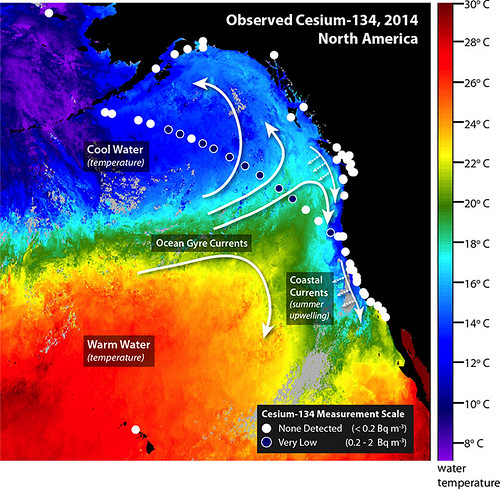科學家首次在美國加州外海偵測到微量放射性化合物,來源是2011年日本太平洋外海地震引發的福島核災。有輻射反應的海水樣本,已送至伍茲赫爾海洋研究所,交由研究船上的志工團隊進行分析。
福島核災放射物落腳美外海 含量低不致傷害人體
這些海水樣本採自尤里加西方150公里處的外海,樣本中含有福島核電廠反應爐熔毀放出的放射性元素─銫134,但國際衛生機關表示,測得的含量非常低,比美國國家環境保護局(EPA)規定的飲用水標準容許含量還低1千倍,不致傷害人體或海洋生物。
這些新數據中,銫134的含量低於每立方公尺2貝克。
伍茲赫爾研究所的測量結果在2014年2月夏威夷火奴魯魯的科學會議上獲得確認,提供第三方數據資料的是是加拿大漁業及海洋部的科學家史密斯,他搭乘的研究船在更早的航程中,從加拿大太平洋外海採集海水樣本,測得與伍茲赫爾相似的放射物含量。
核武、核災 非自然放射性汙染物海中擴散
布韋賽勒又說,「很少人知道在福島核災之前,太平洋中就有銫了,但那時還只有放射性同位素銫137,半衰期30年,1950至1960年代的核武測試之後就存在於自然環境中,不過,除了銫137,我們還測出銫134,兩者都不是自然環境產生的,銫134的半衰期只有兩年,這就表示現在太平洋中的銫134一定是源自日本福島。」
2011年3月11日的地震和隨之而來的海嘯襲擊日本後,位於太平洋海岸的福島第一核電廠電力中斷,無法啟動水泵以冷卻廠房內的6座反應爐,因此廠房爆炸、爐心熔毀,釋出銫134與其他放射性元素到海洋中,濃度之高,史無前例,含有放射性元素的海水水流之後隨著洋流向西流經太平洋,沿途與海水稀釋並擴散。
2011年福島核電廠發生意外時,當地外海的放射性元素含量達到高峰,比近來在北美海域測出的數值還高出1千萬倍。
伍茲赫爾的海洋化學家布韋賽勒目前督導整個監測計畫,他表示,「我們在加州沿海測出來自福島的銫134污染物,我們必須使用能測出微量放射物質的精密儀器,才能知道含量。」
電腦模擬預測 核汙染將抵阿拉斯加、夏威夷
科學家也使用了電腦模型來預測銫134抵達阿拉斯和加拿大的時間及含量。他們預測,沿著北美海岸往南延伸的海域,未來都可偵測到銫134,最後反向迴流至夏威夷,但是目前不同電腦模型所預測的結果相差甚遠。
布韋賽勒接著說,「我們還不曉得海岸邊何時候可以測到銫134,因為很難預測外海表層海水何時會與沿岸海水混合,而且沿海洋流以及近岸湧升流的深層冷水都會阻礙這種混合現象。今年冬天我們會趁湧升流不多時採集樣本,此時沿岸與外海海水有比較多機會混合。」
由於目前美國聯邦政府沒有人資助這項海岸核污染監測計畫,布韋賽勒自行發起群眾募資並聚集公民科學家一起號召大眾蒐集海水樣本、提供銫同位素的最新數據,採樣範圍包括北美及夏威夷西岸。
布韋賽勒在1月提出這項計畫後,包含個人與團體,已貢獻超過50個海水樣本,並將捐款用於樣本分析工作,阿拉斯加到聖地牙哥海岸及夏威夷北海岸的分析結果公布在其網站。目前,布韋賽勒實驗室的所有樣本中都未出現來自福島的銫134,每公秉含量皆低於偵測標準的0.2貝克。
群眾募資 美、加合力監控海岸核汙染
布韋賽勒和史密斯現在一起合作,開啟一項新計畫,名為InFORM,計畫主持人是加拿大卑斯省維多利亞大學的庫侖,合作對象包括加拿大學界、政府單位及非政府組織,致力於化解福島環境污染物對加拿大太平洋、北極海岸及沿岸居民的威脅。
布韋賽勒認為,放射性物質橫越太平洋的擴散情況還不明朗,態勢刻不容緩,需要長期、謹慎的監測。
他也說:「群眾募資很重要,不僅讓民眾也參與其中,還指出海岸到底發生了什麼事,但海洋科學家必須在海上進行更多研究才能了解洋流是如何把銫沖到岸邊。電腦模型確實告訴我們銫含量會在接下來2到3年逐漸增加,但無法預測稀釋程度或受污染的海水會在哪裡率先登陸。」
「因此,需要公民科學家一起加入監測網絡,也要有研究船進行全面性的海上研究,這些支出對一般民眾而言實在吃不消。」
In California waters for the first time, scientists have detected trace amounts of signature radioactive compounds from the Fukushima Daiichi Nuclear Power Plant accident triggered by the 2011 earthquake and tsunami off Japan’s Pacific coast.
The radioactivity came from water samples collected and sent in August to the Woods Hole Oceanographic Institution in Massachusetts for analysis by a group of volunteers on the research vessel Point Sur sailing between Dutch Harbor, Alaska, and Eureka, California.
Collected 100 miles (150 km) due west of Eureka, the water samples were found to contain the specific form of radioactivity released into the ocean by the nuclear meltdown at Fukushima Daiichi – cesium-134.
This Fukushima-derived cesium is far below where one might expect any measurable risk to human health or marine life, according to international health agencies. It is more than 1,000 times lower than acceptable limits in drinking water set by the U.S. Environmental Protection Agency.
In the aftermath of the March 11, 2011 earthquake and resulting tsunami that hit Japan, the Fukushima Daiichi nuclear plant on Japan’s Pacific coast suffered a power outage that killed the power supply to the water pumps that cooled the nuclear fuel in the plant’s six reactors.
The resulting explosions and meltdowns released cesium-134 and other radioactive elements into the ocean at unprecedented levels.
Since then, the radioactive plume has traveled west across the Pacific, propelled by ocean currents and being diluted along the way.
The Woods Hole results confirm data described at a scientific meeting in Honolulu in February 2014 by John Smith, a scientist from Fisheries and Oceans Canada in Dartmouth, Nova Scotia, who found similar levels on earlier research cruises off Canada’s Pacific coast.
At their highest near the damaged nuclear power plant in 2011, radioactivity levels peaked at more than 10 million times the levels recently detected near North America.
“We detected cesium-134, a contaminant from Fukushima, off the northern California coast. The levels are only detectable by sophisticated equipment able to discern minute quantities of radioactivity,” said Ken Buesseler, a Woods Hole marine chemist who is leading the monitoring effort.
“Most people don’t realize that there was already cesium in Pacific waters prior to Fukushima, but only the cesium-137 isotope,” explained Buesseler. “Cesium-137 undergoes radioactive decay with a 30-year half-life and was introduced to the environment during atmospheric weapons testing in the 1950s and ’60s.
“Along with cesium-137, we detected cesium-134, which also does not occur naturally in the environment and has a half-life of just two years. Therefore the only source of this cesium-134 in the Pacific today is from Fukushima,” Buesseler said.
The amount of cesium-134 reported in these new offshore data is less than 2 Becquerels per cubic meter (the number of decay events per second per 260 gallons of water).
Scientists have used models to predict when and how much cesium-134 from Fukushima would appear off the shores of Alaska and Canada. They forecast that detectable amounts will move south along the coast of North America and eventually back towards Hawaii, but models differ greatly on when and how much would be found.
“We don’t know exactly when the Fukushima isotopes will be detectable closer to shore because the mixing of offshore surface waters and coastal waters is hard to predict. Mixing is hindered by coastal currents and near-shore upwelling of colder deep water,” said Buesseler.
“We stand to learn more from samples taken this winter when there is generally less upwelling, and exchange between coastal and offshore waters maybe enhanced,” he said.
Because no U.S. federal agency is currently funding the monitoring of ocean radioactivity in coastal waters, Buesseler launched a crowd-funded, citizen-science program to engage the public in gathering samples and to provide up-to-date scientific data on the levels of cesium isotopes along the west coast of North America and Hawaii.
Since January when Buesseler launched the program, individuals and groups have collected more than 50 seawater samples and raised funds to have them analyzed. The results of samples collected from Alaska to San Diego and on the North Shore of Hawaii are posted on the website http://OurRadioactiveOcean.org.
To date, all of the coastal samples tested in Buesseler’s lab have shown no sign of cesium-134 from Fukushima. All are less than their detection limit of 0.2 Becquerel per cubic meter.
Buesseler and Smith are now working together on a new project, led by Jay Cullen at the University of Victoria, in British Columbia. Called InFORM, it involves Canadian academic, government and NGO partners who are working to determine and communicate the environmental risks posed by Fukushima for Canada’s Pacific and Arctic coasts and their inhabitants.
Buesseler believes the spread of radioactivity across the Pacific is an evolving situation that demands careful, consistent monitoring of the sort conducted from the Point Sur.
“Crowd-sourced funding continues to be an important way to engage the public and reveal what is going on near the coast. But ocean scientists need to do more work offshore to understand how ocean currents will be transporting cesium on shore,” he said.
“The models predict cesium levels to increase over the next two to three years, but do a poor job describing how much more dilution will take place and where those waters will reach the shore line first,” said Buesseler.
“So we need both citizen scientists to keep up the coastal monitoring network, but also research vessels and comprehensive studies offshore like this one, that are too expensive for the average citizen to support,” he said.
Buesseler will present his results on Thursday at a conference in Vancouver hosted by the Society of Environmental Toxicology and Chemistry, or
SETAC, an independent, nonprofit society.
※ 全文及圖片詳見:ENS
※ 本文為教育部科學人文跨科際人才培育計畫(簡稱SHS計畫)所屬南區區域推動中心,舉辦「環境新聞編譯工作坊」之成果展現,特別感謝《科學人》編輯群協助審校。






